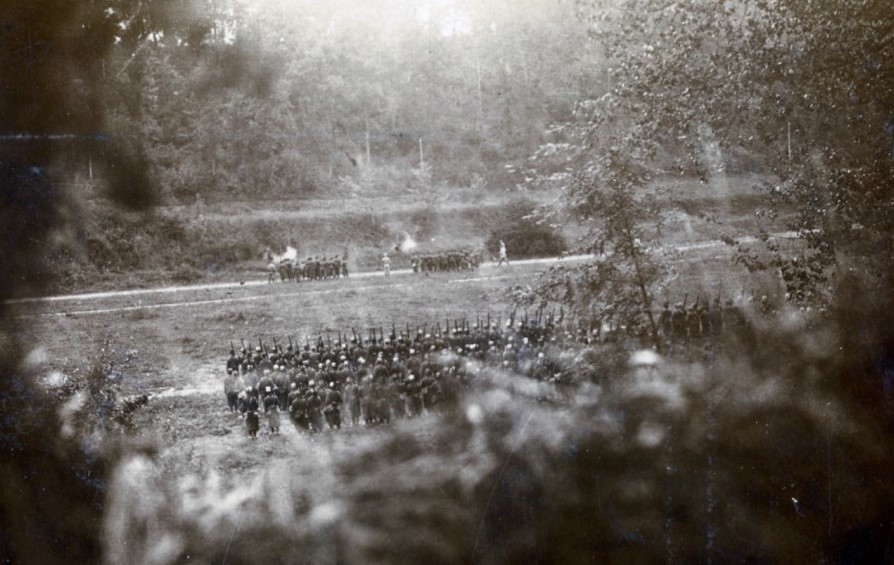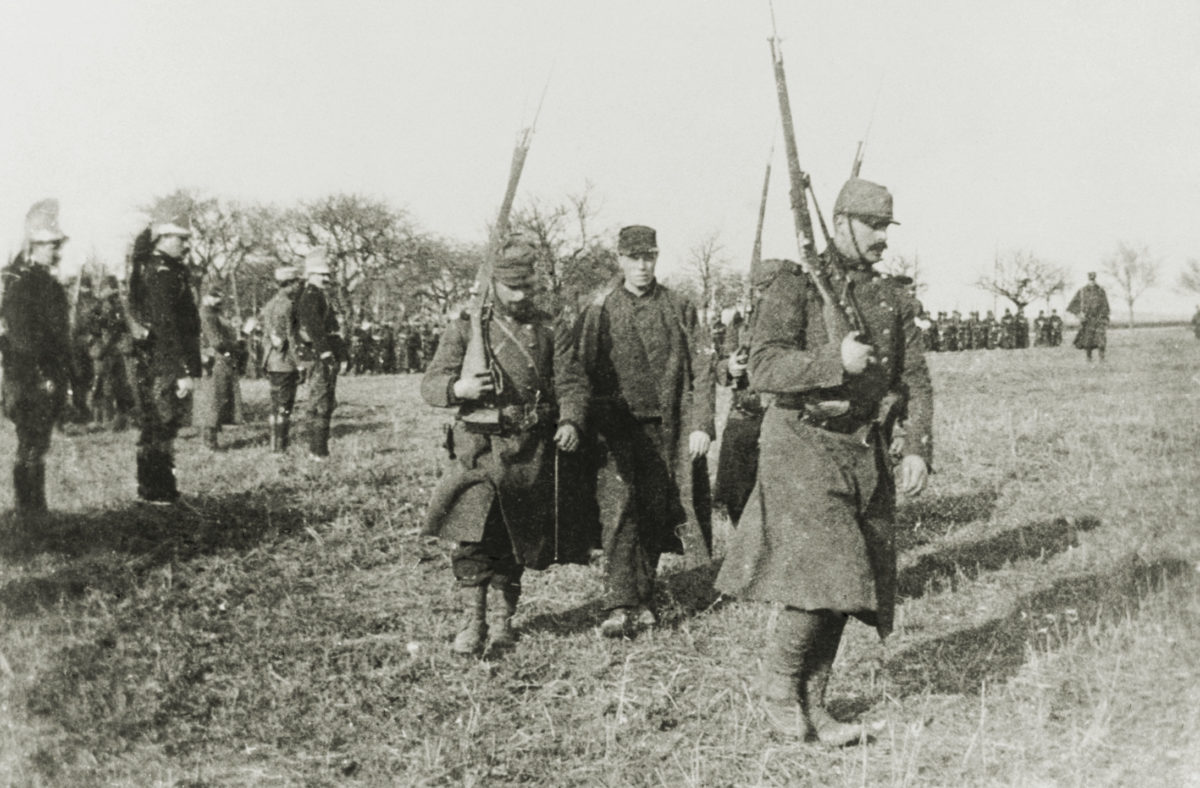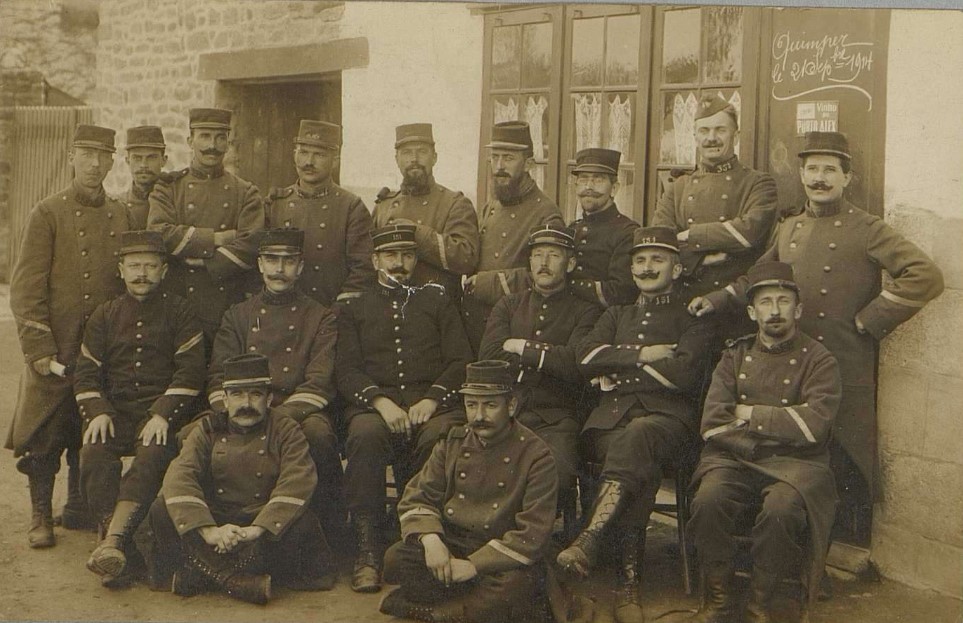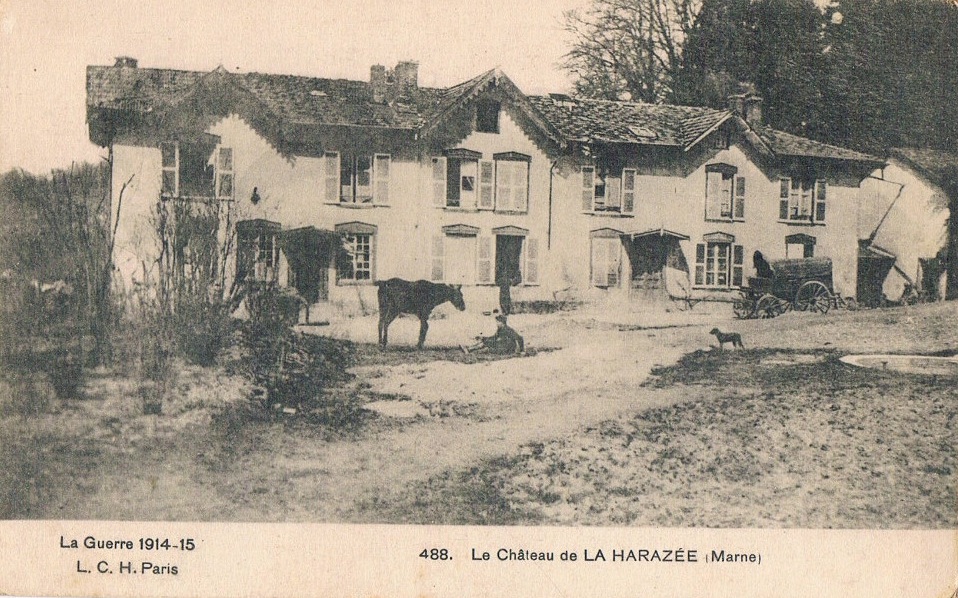Soldiers of the 151e RI Executed in the Great War

Candid photo taken of a French execution in 1915.
Between 1914 and 1918, the French army condemned to death some 2,500 officers and soldiers. Many of these were under the most dubious of reasons and classified simply as “fusillé pour l’exemple” -- "to make an example of." Of those sentenced, the number of those actually executed varies in estimate between 600 to 870. The highest figures put it over 1,000. These estimates do not include summary executions done on the spot (for instance, in the midst of combat). Anecdotally there were many such examples perhaps numbering in the hundreds. The highest numbers of those shot were in the five months of 1914 and in the year 1915 with steady and substantial declines in the years that followed. Added to the difficulty in ascertaining the right number are incomplete, altered or missing files and death certificates for many of those executed. The true numbers will never be known.
There are three known cases of soldiers in the 151e RI who were executed in the war: Soldat Augustin Leduc (shot on 19 October 1914), Sergent-Fourrier Ernest Camus (shot on 31 December 1914), and Soldat Jules Fique (shot 31 January 1915). The details of each being listed below when information was available. While the reasons for their executions may not seem as unjust as compared to the infamous "Six Martyrs of Vingré" or the Sous-Lieutenants Herduin and Millant at Verdun, they are examples of an overly severe military justice system, proof of which can be seen in their rehabilitation immediately after the war.

Unknown French soldier being marched to his execution.
- Class of 1908 - executed on 19 October 1914 at Châlons-sur-Marne (Marne), age 26 years old
- Born on 2 March 1888 at Montrécourt (Nord), recruited at Cambrai
Very little is known about Augustin Leduc and the details around his execution. His death certificate states that he was "fusillé" ("shot by firing squad"), which seems to be an uncommon official cause of death for those executed during the war, as post-war rehabilitations (conducted as early as 1920) typically amend this to read "Mort pour la France" ("Died for France") or "Tué par l'ennemi" ("Killed in action"). There are no further details available on Augustin Leduc aside from what is in his death certificate, aside from the fact that his name appears on Montrécourt Monument to the Dead.

- Class of 1900 - executed 31 December 1914 at Poperinghe (Belgium), age 34 years old.
- Born 29 March 1880 at Buironfosse (Aisne), recruited at St. Quentin.
The full dossier on Camus’ case, including personal papers, soldier booklet, photos, and the official documentation of his court martial, can be found here
On New Year’s Eve, Sergent-Fourrier Ernest Camus – Class of 1900, husband and father of two children – was "Fusillé pour l'exemple" (“shot as an example”) – as the sun rose over Poperinghe, Belgium. Camus had been sentenced to death for the charge of abandoning his post in the face of the enemy and though there were extenuating circumstances, the cold heart of military justice rendered a judgement of “condamné à la peine de mort."
Ernest Gabard had followed in the footsteps of his father and worked as a clog-maker in Chauny (Aisne). He had done his active service with the 128e RI, eventually being promoted from caporal to sergent-fourrier in 1904. But concerns over his personal conduct arose in 1905 when he was appointed as a foot constable with the 2e Gendarmerie Legion in Ham (Somme). This was where his “bad behavior” began. He was punished for what seems the trivial offense of going dancing while in uniform and then for the more serious charge of being absent from duty without permission. He later appeared before a board of inquiry for “indelicacy and borrowing money from a young girl in promise of marriage” and the next year was discharged from the gendarmerie and struck off the rolls. Camus moved to Chauny in March 1914 and worked as a clog-maker when he was mobilized on 2 August 1914 and assigned to the 151 on 12 August and appointed to the post of sergent on 7 September. Camus spent the first few months of the war at the regiment’s new depot at Qumiper.
Chauny was one of the many towns in the Aisne overrun by the enemy during the German army’s advance in the hectic days of September 1914. Camus penned a letter to the town mayor on 4 November while at the regimental depot in Quimper to inquire about the whereabouts of his wife and father. Although he believed his family had been evacuated, he had received no news of them since the war began. It is difficult to imagine what hardship Camus must have underwent as he had to bear the ordeal of not just the rain, mud, cold, danger and death of the trenches in Belgium but to do so while struggling with the torturous uncertainty of his family’s well-being. Where were they? How were they? Were they safe? Were they healthy and warm? He had no knowledge of them, received no word of support and comfort from them.
Camus had arrived with the regiment on the frontlines in Belgium on 17 November as one of the detachment of 487 officers and men replacements sent from the depot. Just one week before, the regiment had lost two-thirds of its effective in the surprise German assault on the Yser. Camus found himself among a human debris field that followed in the wake of this disaster, the regiment reduced to the strength of a single weakened battalion that had been temporarily reconstituted into three companies. With the arrival of the replacements, 1 and 2 Bats. were reconstituted with Camus assigned to the remnants of 8 Co. (2 Bat.) under Sous-Lieut. Couplet).
On 8 December, the regiment changed sectors, shifting down to the Zillebeke–Verbranden Mollen--Kruisstraat subsector. On the morning of 23 December, 8 Co. was two days into his rotation in the first-line trenches near Zwartelen when Camus reported to Sous-Lieut. Couplet that he was ill and requested to go see the regiment’s doctor. But instead of going to the medical post, Camus (while having on him the company’s funds for repayment of food) took a detour and stopped in a cafe “A la Tour” on Rue au Beurre in Ypres for a drink, some food and a shave, in addition to purchasing some civilian clothes and a pair of binoculars, using the company funds to pay for everything. While there he had been spotted dressed in a knitted sweater and wearing clogs by another sergeant who informed Sous-Lieut. Couplet. The officer immediately requested that Camus be referred to the Conseil de Guerre for “desertion in the face of the enemy, carrying military weapons and effects, and misappropriation of the company loan.”
Days went by before an intoxicated Camus was found and arrested by the Gendarmerie on 28 December 1914 in another establishment in Ypres. Once he had sobered up, he expressed regret and promised to repay his debt, and was emphatic that his intention was not to desert. On 30 December he was brought before the Conseil de Guerre at the 151 command post at Poperinghe, with Commandant Debieuvre acting as president, Sous-Liuet. Teisserenc and Adj-Chef Chiarelli as judges, Lieut. Bonnet as government commissioner, and Adj. Coltant as clerk. After reviewing the details of the case, including depositions taken by other witnesses, Camus was found guilty of abandoning his post in the face of the enemy and sentenced on the same day to death. That Camus had likely been suffering from acute anxiety and depression caused by the unknown fate of his family were not taken into consideration. These were desperate times and French authorities responded with severe measures. No mercy could be shown to those judged as shirking their duty.
For the execution platoon, Colonel Dillemann prescribed the following: I. 2 sergents from 2 Bat., 1 sergent from 1 Bat., and 1 sergent from 3 Bat., all drawn from the oldest veterans of the battalions. II. 2 caporaux and 2 soldats from 2 Bat., 2 caporaux from 1 Bat., and 2 soldats from 3 Bat., all drawn from the oldest veterans of the battalions. III. A 5th sergent from 3 Bat. is responsible for delivering the coup de grâce and a fifth soldat responsible for tying the condemned's eyes with the blindfold. IV. Commanded by Adj. Ottavi (4 Co.).
At 4:50 AM the three battalions of the 151 were formed up at a location in Poperinghe indicated verbally by Colonel Dillemann., with the 1 Bat. in line facing to the northeast parallel to the path going from the CP to Schandemont - Hipshoekbeek, the 2 Bat. perpendicular to the first stacked in mass (owing to the limited space), and the Bat. in line on the edge of the path facing the 1 Bat. At the same time, a platoon of 50 men from 4 Co. formed up at the CP at the shoulder arms to escort the condemned to the wooden post erected beside two walls. Before setting off, the sergent commanding the platoon conducted the ceremonial shaming rituals of cutting away his coat buttons and tearing off his rank stripes.
Camus was marched to the execution ground where he was placed with his back against the post, then blindfolded and made to kneel by the 5 picked men. As this was done, Adj. Coltant (who’d acted as the clerk on the Conseil de Guerre) read the sentence in the loudest possible voice. It was 5:00 AM. The execution platoon being formed up with loaded rifles along the front of 1 Bat. was given the order to advance and marched to within 6 meters of Camus. Then Adj. Ottavi raised his sabre and pointed with it to the middle of Camus' chest to indicate the target and signal the men to aim. Ottavi then gave the command “Feu!” and the men unloaded their rifles into Camus, whose body slumped down to the ground. The fifth sergent advanced up to the body, placed a revolver 5 cm above Camus’ ear, and delivered the coup de grâce.
The battalions then defiled in column of fours at the shoulder arms past the body and proceeded to the road to march back across the border into France. The regimental colors and the color guard marched to the center of 2 Bat. As the burial party, composed of a caporal-sapeur and 3 sapeurs equipped with shovels and picks, set to work burying the body.
Ernest Camus, husband and father of two children, was dead. Whether accidentally or as a deliberate post-war concession, Camus’ death certificate states his cause of death as “tué à l'ennemi" (“killed in action”). He was not the first, nor would he be the last soldier of the 151 executed (another would be shot a month later to the day, which will be discussed later).
- Class of 1909 - executed on 31 January 1915 at La Harazée (Marne), age 25 years old
- Born on 1 July 1889 at Ognes (Aisne), recruited at Laon (Aisne).
The full dossier on Fiquet’s case, including personal papers, soldier booklet, and the official documentation of his court martial, can be found here.
Assigned to the 7e Compagnie, 2 Batallion, Jules Fiquet had become separated from his unit (like so many others) in the slaughter and chaos of the German onslaught of 10 November 1914. Unlike most of his comrades however, he had failed to return to the 151e but was found loitering just behind the frontlines. Arrested under suspicion of being deserting his unit, Fiquet was sentenced to death for abandoning his post in the face of the enemy. He was sent back to the regiment then fighting in the Argonnne where he was "Fusillé pour l'exemple" (“shot as an example”) in front of his comrades as they were coming off the line on the night of 31 January 1915.
Jules Fiquet was a simple laborer before the war. Born in the tiny village Ognes (Aisne) and residing first in Bichancourt (a hamlet of Coucy-le-Chateau, Aisne) with his parents, Fiquet had done his pre-war service with the 151e RI, having first received a year's deferment when he was called up in October 1910 due to a bad case of syphilis before reporting again in September 1911. In 1913, the same year his mother passed away, he moved Paris, residing at 38 Rue de la Montagne in the 5th Arrondissement. During his time in service, Fiquet committed a series of minor offenses recorded in his soldier's booklet that highlights the draconian nature of pre-war military training. Such offenses included not cleaning his mess-kit properly when it was found that some remains of vegetables were found inside, not coming to attention in one instance, missing and showing up late to roll calls on a couple occasions, being present at a guard inspection with mud on his trousers and leathers not greased, and his boots not blackened enough on another occasion, having misplaced a potato peeler, and resting his rifle by his side while on sentinel duty [counter to regulations]. Perhaps most amusing of all was an incident where a caporal had observed Fiquet spit on the floor in a room. When he was confronted by the caporal, Fiquet quipped, "Well, I don't have a spittoon in my pocket." For his offense and insubordination, he spent eight days in the brig.
The German attack against the French positions along the Yser (Belgium) on 10 November 1914 -- having the advantage of the cover of heavy fog and with the 151e RI occupying a bombarded, precarious position -- caught the regiment completely by surprise. In the greatest single day's loss for the 151 in the entire war, an estimated 1,230 (64%) of the 1,930 men and officers were killed, wounded, or captured. In the initial chaos as soldiers became dispersed and mixed in with other units, Jules Fiquet was reported missing. Fiquet would later claim that he had become separated from the 7e Compagnie along with several other comrades. It wasn't until nearly a month later on 7 December that he turned back up at the Von Bromme farm in the village of Krombeke, which was being used as a billets for the 8e Régiment d'Artillerie, 2e Echelon (20e CA). When he was approached by a brigardier, Fiquet claimed his name was Dubois and that he was part of a resupply echelon of 4e Compagnie, 79e RI before heading off in the supposed direction of that group. When he was later confronted again, this time going in the opposite direction that he had previously indicated, he gave a different name and stated he was in a Belgian unit. Now he was carrying an old (Gras) rifle and sabre bayonet and claimed to be a road guard.
Such conduct naturally raised suspicions and he was soon placed under arrest by the Belgian gendarmes for being absent without permission from his unit and taken to the gendarme provost of the 32e Corps d'Armée on 8 December. Under interrogation, Fiquet first claimed he had been separated from the 151e on 1 January at Ypres. However, the regiment had already left Ypres the night of 29-30 Dec. and was at Wemaers-Cappelle close to le Cassel at that time. After further scrutiny, Fiquet admitted he had lost the 151 after the 10 November attack and wandered with several other comrades but then had gotten separated from them at Poperinghe. After staying the night at a cafe in St. Jean, Fiquet said he had first fallen in with some Belgian troops before claiming to have joined the 79e RI at Ypres. He then left this regiment to rest where he was found at Krombeke. On 17 January Fiquet was remitted to the provost of the 8e Armée
As there was no one left in the newly reformed 7e or 8e Companies who could provide additional information on Fiquet, this confusing and at times conflicting information had to be taken at face value. Yet the case against Fiquet was pretty damning. What happened next is not entirely clear. Fiquet was transported back to the 151 in January -- which had then changed sectors and was fighting in the Argonne Forest -- to be sent before a Conseil de Guerre. A report dated 29 January from Capitaine Carré (7e Co.) stated that Fiquet had been arrested on 17 January and taken back to his company on 24 January. Once back, he pretended to have trench foot to get out of having to take part on an attack by the 7 Co. on a German sap. This implies that Fiquet had been reincorporated into the ranks until the time of his trial.

La Harazée chateau.
Whatever may be the case, on 24 January Fiquet was brought to La Harazée to a building that was serving as the regiment's first-aid post (likely La Harazée chateau) to appear before the Conseil de Guerre, which was presiding over by Commandant Debieuvre (commanding 2 Bat.), with Lieut. de Ste. Croix and Adj. Lelorrain acting as judges, Lieut. Huvet as government commissionerand Adj. Coltant as clerk again (he clerked for Camus' Conseil de Guerre). Fiquet was found guilty of desertion and abandoning his post in the face of the enemy and sentenced to death.
The execution was scheduled for 31 January 1915 at 8:00 PM. As the 2 Bat. was rotated off out of the first-line trenches, the battalion formed up in the La Harazée to attend Fiquet's execution. The details of how the execution was conducted have not been recorded. However, Colonel Dillemann instructed that it be carried out according to regulations. Having executed Sergent-Fourrier Camus just a month prior, it likely unfolded in a similar fashion, with a blindfolded Fiquet having his sentence being read aloud by Lieut. Coltant before the battalion before the firing platoon approached to within 6 meters and unloading into his chest at the command "Feu!"
Oddly enough, Fiquet's death certificate lists him as being "Tué par l'enemmi" ("Killed in action") on 26 September 1914 at Sillery (Aisne), a judgement that was rendered on 4 March 1921.





